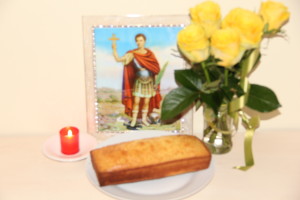 The 19th of April is the Feast of Saint Expedite, one of my favorite patron saints. He is the patron saint of speedy resolutions and is called upon when one needs his or her prayers to be answered quickly. Expeditus was a Roman solider who, upon receiving a vision, converted to Christianity immediately on the battlefield after which he was promptly martyred. His willingness to convert immediately and not put it off earned him the reputation as the patron saint of fast responses. He has a particularly large following in New Orleans where he is a tremendously popular folk saint whose help devotees seek for all sorts of reasons. There is a famous statue of him enshrined in Our Lady of Guadalupe chapel on Rampart Street across from Saint Louis Cemetery where people make offerings and request the saint’s help.
The 19th of April is the Feast of Saint Expedite, one of my favorite patron saints. He is the patron saint of speedy resolutions and is called upon when one needs his or her prayers to be answered quickly. Expeditus was a Roman solider who, upon receiving a vision, converted to Christianity immediately on the battlefield after which he was promptly martyred. His willingness to convert immediately and not put it off earned him the reputation as the patron saint of fast responses. He has a particularly large following in New Orleans where he is a tremendously popular folk saint whose help devotees seek for all sorts of reasons. There is a famous statue of him enshrined in Our Lady of Guadalupe chapel on Rampart Street across from Saint Louis Cemetery where people make offerings and request the saint’s help.
I have blogged more extensively about Saint Expedite in the past, but today I wanted to revisit this powerful and miraculous saint partly because his service is one of the most commonly requested of me and also because there is so much misinformation regarding Saint Expedite that many people approach him from a place of fear and intimidation. Many people come to me saying that they’ve heard that St. Expedite will cause you bad luck or take away what he has given you if he is not served properly. This is completely and totally not true! Saint Expedite is kind and loving and wants only to help those who request favors of him. His life is an example of faith and service to God and humankind. There are traditional offerings associated with this saint that should be given as a sign of love, respect and gratitude once a prayer has been granted or anytime in thanksgiving for the saint’s protection and patronage over us, but you need not approach Saint Expedite with fear. Call on him always with love and trust in your heart.
When seeking the help of Saint Expedite, the traditional process is to make your request by lighting a candle in front of his image and once your request is granted, you immediately thank him with an offering. Saint Expedite’s absolute favorite offering in pound cake. It is not exactly clear where this tradition springs from, but it is deeply entrenched in Louisiana popular folklore and religion. It is even believed that it has to be Sara Lee store bought pound cake. Where I currently live, Sara Lee pound cake is not available so I have to make it from scratch. I find that the more effort and love you put into an offering, the nicer and more meaningful it becomes. No matter what, when you present an offering to Saint Expedite or any saint, what’s most important is to do it with love and gratitude in your heart. If you are not able to buy or make a pound cake, some flowers or even making a small donation to charity in his name are wonderful ways to honor and thank this miraculous saint.
I hope you have enjoyed this post. If you decide to seek the help of Saint Expedite, remember to do so with love and trust and to thank him properly once your request is granted and please share your experiences with St. Expedite and with all things spiritual with me! As always, I thank you for taking the time to visit my blog and I wish you peace, happiness and abundant blessings!
Traditional Offerings
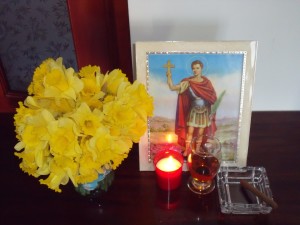 In the last blog post, we examined in general the practice of making food offerings to spirits and discussed making an ancestor feast, which is the cornerstone ritual of New Orleans Voodoo. In this post, I would like to expand upon this topic and share a few specific offerings that are traditional to various lwa or saints. The following list of saints and spirits are not specific to any one spiritual pantheon but are rather an eclectic mix coming from Haitian Vodou, New Orleans Voodoo and Santeria and are the most popular spirits about whom I am asked in my practice as a spiritual worker.
In the last blog post, we examined in general the practice of making food offerings to spirits and discussed making an ancestor feast, which is the cornerstone ritual of New Orleans Voodoo. In this post, I would like to expand upon this topic and share a few specific offerings that are traditional to various lwa or saints. The following list of saints and spirits are not specific to any one spiritual pantheon but are rather an eclectic mix coming from Haitian Vodou, New Orleans Voodoo and Santeria and are the most popular spirits about whom I am asked in my practice as a spiritual worker.
In Voodoo and Santeria the dead come before the saints. Many practitioners of Voodoo also claim that the ancestors work much faster than the saints since they know us personally and they also benefit when they help us by paying back their karmic debt. The hierarchical spiritual order is always God first, then the ancestors and then the saints. You can make an offering to your own ancestors and spirit guides any time of year to request special favors or to thank them for help they have given, but the most traditional time of year to pay homage to the dead is the period between October 31st and November 2nd which his known in Voodoo as Fête Ghede. The feasts prepared for the dead this time of year are quite elaborate. Also, the traditional day of the week of the honor our ancestors and guardian spirits is Monday and we should remember them by lighting a candle or placing a small offering or maybe even just saying a quick prayer for them. As mentioned in the previous post, the food associated with the ancestors are generally white, bland and salt-less foods. Bread, white rice, pancakes, flour dumplings and popcorn are all good options. In terms of drink, you can give them water, rum, beer and black coffee and pretty much anything else. You can make the offerings directly on your altar if you have one or simply create a quiet place where the offerings can be placed undisturbed. Light a white candle when you lay out your offerings and talk to your ancestors as if they were right in the room with you. Allow the candle to burn out on its own and leave the offerings in place overnight. The following morning you can dispose of them ideally outside somewhere in nature.
The first of the lwa that we should mention is Papa Lebga. Legba is seen as the gatekeeper to the spirit world and is petitioned at the beginning and end of every Louisiana Voodoo service as well as Haitian Vodou ceremony to facilitate communication with the other lwa. He is associated with Saint Peter who in Catholic iconography holds the keys to Heaven. In addition to his role in official ceremonies, Legba can also be petitioned to help remove blockages that hold a person back and clear the path to success in life. His favorite offerings include yams, beans, rice and most of all cigars and rum. Offerings may be made in front of a statue or image of Saint Peter or directly on your home altar. The Orisha Ellegua holds a similar role in Santeria. Years ago, a Puerto Rican Santera taught me a simple yet proven effective way of making an offering to Ellegua. You simply take a few pieces of hard candy and a few pennies, I usually use three of each, and discretely drop them on a street corner and make a quick request of Ellegua. I have seen such requests answered dozens of times.
Another important lwa is Ogun who in Voodoo is associated with Saint James the Greater. He, among other patronages, is the spirit of work and employment and I often recommend that people make an offering to him when seeking a new job. His favorite offerings are rum, cigars and mashed black eyed peas drizzled with palm oil. You can make the offering to him in front of an image of Saint James or you can leave it outside next to railroad tracks, which is a place with which he is identified. When making an offering to Ogun for a job, it’s advisable to also make an offering to Erzulie Freda to ensure that the job pays well and has good benefits and is not back-breaking hard work. An appropriate offering to Erzulie would be some pink flowers or a glass of champagne.
An important Orisha in the Yoruba Pantheon is Chango who is associated with Saint Barbara. He can be petitioned in matters of love, passion and protection against enemies. I have written more extensively on Chango, but today I wanted to share two offerings that are known to be his favorite. The first is called amala and is based on a traditional West African dish made with yam flour. The version with which I am most familiar as an offering is made by adding corn meal to boiling water until it thickens and then adding chopped okra. The result is a slimy porridge that may not look appetizing, but most cooked offerings to the orishas tend to be bland and not entirely flavorful. Another offering involving cooking peeled and cored apples until they reach an apple sauce like consistency and mixing in red wine and cinnamon. Red wine itself is a suitable offering to Chango. You can place offerings to Chango in front of a statue or image of Saint Barbara or directly outside in nature, ideally somewhere near a lake or a pond. All offerings presented to any Orisha or spirit should be room temperature.
In the Yoruba tradition, Ochun is in embodiment of beauty, love, sensuality and wealth. She makes her home in the river and lives a life of luxury and pleasure. Her favorite offing by far is honey as she herself is the essence of sweetness according to her devotees. You can drizzle a few drops on honey directly into an outdoor stream as well as toss in five pennies and make a request to Ochun. You can also place a saucer of honey in front of her image. No matter what, when you present and offering of honey to Ochun, it’s important to taste it in her presence as there is a legend regarding tainted honey being presented to her. Yellow flowers, especially roses, are a suitable offering as well. She can help in matters of love and money.
In Santeria, the Orisha Yemaya is the embodiment of the ocean but also represents good health, motherhood and stability. She is also very protective of her devotees. In Voodoo, Madame La Sirene fills a similar role and as her name would indicate, she is often portrayed as a mermaid (La sirère is the French word for “mermaid.”) Many offerings are made to her during New Year’s celebrations to ensure luck, good health and stability in the year to come. Each year, sometime in late December, I make a paper maché float and fill it with offerings to Yamaya and place it directly into the ocean. Her favorite offerings include molasses, flowers and sweet pastries. The ideal way to make an offing to Yamaya or La Sirene is to place it directly into the ocean. If this is not possible, you may present the offerings at home and light a white or blue candle and make your request. As always, leave the offering in place overnight and dispose of it somewhere in nature the following day. Another interesting way of seeking Yemaya’s blessing was taught to me years ago by a Puerto Rican Santera. You can pour a jar of molasses over your body and submerge yourself in the ocean until the ocean water washes you completely clean. While you are bathing in the ocean, ask for Yemaya’s blessing and protection. You can also toss 7 pennies directly into the ocean as an offering to request luck and protection. As with all saints and spirits, remember to be thankful and respectful when dealing with Yemaya.
I hope you have enjoyed learning about these specific offerings to various spirits and I’m sure I will list more in the future. If you decide to make an offering please let me know how it goes. As always I wish you peace, happiness and the sweetest of blessings!
The Feeding of Ancestors and Spirits
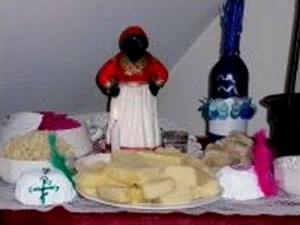 In many spiritual traditions around the world as seemingly disparate as Chinese Folk Religion, Haitian Vodou, Brazilian Candomblé, European Faerie Magic and various forms of Native-American Shamanism and Hinduism you will notice one common trend: The Feeding of Ancestors and Spirits. In all of these traditions and many others, elaborate feasts are prepared for different categories or pantheons of spirits depending of the time of year or celebration being observed or the spiritual assistance one is attempting to seek. The prescribed offerings and the types of spirits invoked through food offerings vary from culture to culture, but making food offerings is a universal theme. The need to feed incorporeal entities may seem strange, yet the question arises: why is it such a fundamental aspect of so many spiritual traditions around the world?
In many spiritual traditions around the world as seemingly disparate as Chinese Folk Religion, Haitian Vodou, Brazilian Candomblé, European Faerie Magic and various forms of Native-American Shamanism and Hinduism you will notice one common trend: The Feeding of Ancestors and Spirits. In all of these traditions and many others, elaborate feasts are prepared for different categories or pantheons of spirits depending of the time of year or celebration being observed or the spiritual assistance one is attempting to seek. The prescribed offerings and the types of spirits invoked through food offerings vary from culture to culture, but making food offerings is a universal theme. The need to feed incorporeal entities may seem strange, yet the question arises: why is it such a fundamental aspect of so many spiritual traditions around the world?
 Spirits do not have corporeal bodies as do living beings and therefore do not require food for sustenance, yet so many spiritual traditions require the feeding of the dead as well as the particular spirits associated with the tradition in question, in Louisiana Voodoo, the tradition with which I am most familiar, these spirits are known as lwa. There are two main reasons to support and explain the practice of feeding spirits. First, it is a sign of respect and kindness just as you would prepare a meal for family and friends, you can do the same for friends and family who have crossed over to the other side or for saints to show your gratitude and respect. Making food offerings to spirits is quite common at festivals throughout the world such as the Mexican Days of the Dead, the Chinese Hungry Ghost Festival or the Japanese Obon celebration. Secondly, on a metaphysical level, when we request the help of a spirit or saint in carrying out a task or achieving a certain goal, we make food offerings to them so that they can take the energy generated by the offerings and use it to our advantage to manifest our desired goals on the physical plane. There are the main reasons why presenting food offerings to spirits is so common throughout the world in various magical and spiritual traditions.
Spirits do not have corporeal bodies as do living beings and therefore do not require food for sustenance, yet so many spiritual traditions require the feeding of the dead as well as the particular spirits associated with the tradition in question, in Louisiana Voodoo, the tradition with which I am most familiar, these spirits are known as lwa. There are two main reasons to support and explain the practice of feeding spirits. First, it is a sign of respect and kindness just as you would prepare a meal for family and friends, you can do the same for friends and family who have crossed over to the other side or for saints to show your gratitude and respect. Making food offerings to spirits is quite common at festivals throughout the world such as the Mexican Days of the Dead, the Chinese Hungry Ghost Festival or the Japanese Obon celebration. Secondly, on a metaphysical level, when we request the help of a spirit or saint in carrying out a task or achieving a certain goal, we make food offerings to them so that they can take the energy generated by the offerings and use it to our advantage to manifest our desired goals on the physical plane. There are the main reasons why presenting food offerings to spirits is so common throughout the world in various magical and spiritual traditions.
The types of food that we offer to spirits varies from culture to culture and the type of spirits we intend to invoke. In Asian cultures, the food offered to the spirit world tends to be exactly what people enjoy easting. In Afro-Caribbean spiritual traditions, food offerings tend to be quite simple and bland with the exception of the dishes offered to the Ghede and some Petro lwa in Haitian Vodou which tend to be heavily spiced with black and red pepper. In New Orleans Voodoo, my area of expertise, the most common type of offerings we make are to our own ancestors and personal spirit guides. These offerings are called “white foods” since they are mostly starch or flour based and white in color. White food offerings often include steamed white rice, bread, four dumplings, popcorn, pancakes and corn meal mush. Black coffee, glasses of water and spirituous beverages such as rum, vodka and beer are also offered. When making offerings to the dead, it’s important that the dishes prepared contain no salt, as salt weakens and repels spirits and for this reason it is used in rituals for exorcism and spiritual cleansing. Each of the lwa has his or her own favorite offerings as well. For example Erzulie Freda is partial to champagne, Ogun and Legba enjoy rum and cigars and of course Saint Expedite loves pound cake. Now that we have discussed the type of foods that are traditionally presented to the spirits, I would like to provide instructions for performing and ancestor feast, which is the cornerstone ritual of New Orleans Voodoo.
Start by creating a clear space on a table. If you have preexisting altar, by all means use it to make to perform this offering. If you have a white table cloth, lay it down. Onto the table place a glass of water, and however many white food offerings ad you would like, but at least one. Pop corn, rice, dumplings, bread, pancakes, corn meal mush are all acceptable offerings, but be sure not to include any salt as this weakens spirits. You may also wish to place on the table back coffee and a shot of vodka or another strong white alcohol. Then light a white candle and speak to your ancestors and spirits guides and ask them to confer on you spiritual power and protection and you may ask for whatever other specific favors you would like to obtain.
Allow the candle to burn out on its own and leave the food offerings there overnight. The next day dispose of the offerings outside in nature if possible. You may perform this ritual any time you’d like to request a specific favor and Monday is the most traditional day of the week for invoking the ancestors and spirit guides. November 2nd, All Soul’s Day, is the day of the year sacred to them as well and the feast should definitely be made on that date.
I hope you have found this post to be informative and that you give the ancestor offering a try. When properly cared for, our ancestors and spirits help us tremendously in life. As always, I thank you for taking the time to read my blog and I wish you peace, prosperity and abundant blessings!
Honey Jar Hoodoo Magic
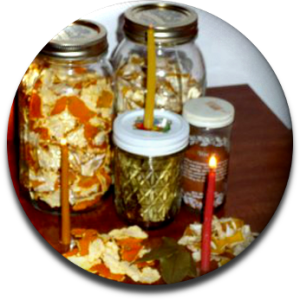 One of the most common services that is requested of me is the Honey Jar, which is the go to love spell of Southern Hoodoo conjuring. Not only can the honey jar be used in matters of love, it can also be used to improve the attitudes of those with whom we interact in a professional or social context. In fact, people often will use honey jars to “sweeten” unpleasant coworkers or bosses and improve how they treat others or even to make a certain situation swing in their favor. Today I would like to teach you a simple version of the honey jar that can be done with ingredients readily available in most kitchens, but before we get to the instructions on how to make a honey jar, it’s important to define two very important terms: Hoodoo and Sympathetic Magic.
One of the most common services that is requested of me is the Honey Jar, which is the go to love spell of Southern Hoodoo conjuring. Not only can the honey jar be used in matters of love, it can also be used to improve the attitudes of those with whom we interact in a professional or social context. In fact, people often will use honey jars to “sweeten” unpleasant coworkers or bosses and improve how they treat others or even to make a certain situation swing in their favor. Today I would like to teach you a simple version of the honey jar that can be done with ingredients readily available in most kitchens, but before we get to the instructions on how to make a honey jar, it’s important to define two very important terms: Hoodoo and Sympathetic Magic.
Voodoo and Hoodoo are separate yet related spiritual practices. In fact, many practioners of Louisiana Voodoo are also experts in Hoodoo. Voodoo is a religion of West African origin that came to Louisiana during the colonial period and was heavily influenced by Haitian Vodou by the influx of Haitian refugees to New Orleans following the toppling of French colonial rule in 1804. Voodoo has an elaborate pantheon of spirits and saints from whom favors can be requested though a series of codified rituals. Communal services and dances are also common in Voodoo. In contrast, Hoodoo is mostly a solitary practice that has its roots in African-American folk magic from the Southern United States which like Voodoo has West African origins but lacks the influence of French Catholicism so prevalent in Voodoo and relies more heavily on European sympathetic magic. In order to understand Hoodoo more clearly, we must examine the concept of sympathetic magic.
Simply put, sympathetic magic is the idea that like affects like in terms of conjuring. For example, in order to influence a person, one might make a doll, painting or drawing in the image of the desired target, ideally including a personal item such as hair, nail clippings or a piece of clothing and cast the spell onto the image resulting in the actual person feelings the effects. This type of magic brings to mind the Voodoo Doll, which contrary to popular belief is not a practice found in Voodoo itself but rather Hoodoo and European folk magic both of which rely heavily of sympathetic magic in their approach to spell casting. Ingredients in sympathetic magic spells tend to represent the desired changes you wish to manifest in the physical world, for example if you want to summon wealth you might grow some flowers and as they grow envision money coming into your life or if there is an unpleasant person in your life you might want to write his or her name on a piece of paper and place it in the freezer to “freeze” that individual from doing further harm. These are both examples of sympathetic magic. Perhaps the most widely known example of sympathetic magic and Hoodoo conjure work is the Honey Jar.
The Honey Jar is a simple spell based on the fundamental idea of sympathetic magic that like produces like. It is intended to draw a person to you and inspire feelings of love. As the name would indicate, honey is a fundamental ingredient. Building a honey jar is fairly easy. Simply place into a jar the name or photo of the person in question. Then add honey and whatever other sweet, pleasant smelling ingredients you’d like. My personal favorites are brown sugar, cinnamon, cloves, nutmeg, molasses and rose petals. You are by no means limited to these items. The only must-have ingredient is honey. Beyond that let your imagination run wild. Once you have added all your ingredients, seal the jar shut and light a pink candle next to it. Meditate for a few moments and envision the person in question being drawn to you and entering into the type of relationship you’d like to have. Allow the candle to burn out on its own and place the honey jar in a discrete location and allow it to work its magic. Another more mild version of a honey sweetening in which the goal is to make a person treat you nicely, but not necessary inspire feelings of love, involves taking a photo or the name of the person in question, smearing it with honey and lighting a yellow candle next to it. I often instruct people to do this when dealing with an unpleasant boss or coworker.
I hope you have enjoyed learning about honey jars and if you decide to create one on your own, please share your experience with me. As always I thank you for taking the time to visit my blog and I wish you peace, happiness and abundant blessings!
Money Drawing Conjure Oil
Tod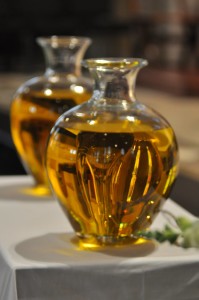 ay I would like to share with you a recipe for a money drawing conjure oil. Using specially consecrated oils to dress candles and talismans is an important part of many magical traditions. Most people tend to buy such conjure oils previously made and blessed by another spiritual practitioner, however it is extremely simple are arguable more effective to make such magical oils yourself. Below is an example of a simple yet power money drawing oil that you may wish to use in the blessing of candles, the preparation of charms and gris gris or even add a few drops of it to your bath water.
ay I would like to share with you a recipe for a money drawing conjure oil. Using specially consecrated oils to dress candles and talismans is an important part of many magical traditions. Most people tend to buy such conjure oils previously made and blessed by another spiritual practitioner, however it is extremely simple are arguable more effective to make such magical oils yourself. Below is an example of a simple yet power money drawing oil that you may wish to use in the blessing of candles, the preparation of charms and gris gris or even add a few drops of it to your bath water.
You will need:
One cup vegetable oil
One tablespoon rue
One tablespoon mustard seeds
One tablespoon sunflower seeds
One green taper candle
Combine the oil with all the other ingredients.
Light the green taper candle and hold your hand over the mixture and say “I charge this oil with the power to draw great wealth. So mote it be.”
Allow the candle to burn out on its own.
Allow the mixture to sit for 5 days and then strain the oil and reserve in an airtight bottle or container.
Use to dress candles or in the preparation of charms or add a few drops to your bath water to create a money drawing bath.
I hope you have enjoyed this post and that you give this simple recipe a try. As always, I wish you peace, prosperity and abundant blessings!